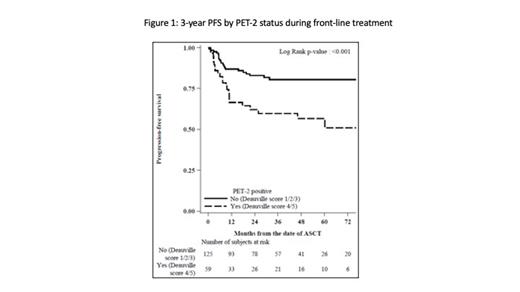Background: Interim PET (PET-2), performed after two cycles of chemotherapy (CT), is widely adopted to select patients (pt) with classical Hodgkin lymphoma (cHL), who might benefit from omitting radiotherapy (RT) or reducing the number of CT cycles in early stages, as well as intensifying or de-escalating first-line therapy in advanced stages. Furthermore, PET-2 has prognostic value in the front-line and in the salvage treatment. In a retrospective multicenter Italian study on patients experiencing failure of first-line treatment, we recently observed that PET-2 seems to be an early unfavorable predictor for subsequent salvage high-dose (HD) CT and autologous stem cell transplant (ASCT).
Aims of Study and Methods: To evaluate the impact of the prognostic factor PET-2, we performed a retrospective observational multicenter study on individual data of 184 pt with relapsed or refractory (R/R) cHL after first-line CT given according to a PET-adapted strategy. R/R pt were treated at 11 Italian centers with one or more lines of salvage CT followed by HD-CT and ASCT from 2009 to 2021.
We compared characteristics and outcomes of 125 PET-2 negative with those of 59 PET-2 positive (PET-2+) R/R pt. Study endpoints included Progression-free survival (PFS) (defined as the time from the date of ASCT to progression or death after ASCT, whichever occurred first), Overall Survival (OS) (defined as the time from the date of ASCT to death from any cause or the last date for which information was available), and factors associated with ASCT outcome evaluated by univariate and multivariate analysis.
Results
Main pt characteristics at relapse or progression among 125 PET-2 negative and 59 PET-2+ pt were as follows: median age 34 vs 32 years, M/F 64/61 vs 28/31, refractory disease 38% vs 76%, early relapse (within 12 months from end of first-line CT) 27% vs 19%, late relapse 35% vs 5%, stage III or IV 43% vs 44%, B symptoms 24% vs 27%, extranodal involvement 26% vs 24% bulky disease 12% each, anemia 9% vs 22%, ECOG PS >1 11% vs 8%. First salvage treatment regimen was BeGEV in 34% vs 14%, IGEV in 34% each, Brentuximab Vedotin +/- Bendamustine in 6% vs 24%, DHAP or DHAOX in 17% vs 24% and other regimens in 10% vs 5% of pt, respectively.
Before ASCT, 95 (76%) in the PET-2 negative and 32 (54%) in the PET-2+ group achieved a complete metabolic remission (mCR).
After a median follow-up of 36 months, the 3-year PFS and OS were 73.8% (95% CI: 66.2-80.0%) and 89.3% (95% CI: 83.0-93.3%), respectively. Figure 1 shows PFS by PET-2 status.
A total of 99 patients underwent ASCT after one line of salvage therapy. At 3 years PFS and OS in patients who underwent ASCT after one line of salvage therapy were 80.6% (95% CI: 68.9-88.3) and 92.2% (95% CI: 82.2-96.7) in the PET-2 negative group, and 56.2% (95% CI: 33.6-73.7) and 90.9% (95% CI: 68.1-97.6) in the PET-2+ group.
Thirty-six patients required two and 14 more than two lines of salvage therapy in the PET-2 negative group; the same figures in the PET-2+ group were 21 and 14. There was no significant difference in PFS or OS by type of salvage therapy received in the two groups.
In univariate analysis PET-2+ during frontline treatment (HR 2.68, P=0.001), anemia (HR 2.18, P=0.038), >2 lines of salvage therapy to enter a response (HR 3.68, P<0.001), achieving less than mCR prior to ASCT (HR 3.19, P<0.001) and RT performed before ASCT (HR 3.11, P=0.017) were associated with inferior PFS. Achieving less than mCR prior to ASCT (HR 2.86, P= 0.026), >2 lines of salvage therapy needed to enter a response prior to ASCT (HR 4.93, P=0.002), anemia (HR 2.96, P=0.040) and checkpoint inhibitors before ASCT (HR=5.10, P=0.032) were adverse prognostic factors for OS, whereas transplant performed after 2012 was associated with improved OS (HR 0.20, P<0.001).
Cox regression multivariable analysis led to the identification of more than two lines of salvage therapy needed before ASCT (HR 3.14, P=0.008) as an independent adverse prognostic factor for PFS. PET-2+ at front-line treatment (HR 1.94, P=0.052), anemia at relapse or progression (HR 2.07, P=0.080) and RT before ASCT (HR=2.52, P=0.086) were associated with increased risk of failing ASCT, although they did not reach statistical significance
Conclusions: PET-2+ during frontline CT may represent an early marker of chemo-refractoriness. Nevertheless, PET-2+ patients experiencing failure of a PET-guided treatment intensification can benefit from a prolonged OS after HDCT and ASCT.
Disclosures
Viviani:Takeda: Other: Travel and meeting accomodation; Beigene: Other: Travel and meeting accomodation. Patti:MSD: Research Funding. Gini:Gentili: Consultancy; Takeda: Consultancy; Incyte: Consultancy; Roche: Consultancy. Derenzini:BEIGENE: Other: Advisory board; TAKEDA: Other: advisory board, Research Funding; ADC Therapeutics: Research Funding; Incyte: Other: advisory board; ASTRAZENECA: Other: Advisory Board; ROCHE: Other: advisory board, Speakers Bureau. Rambaldi:Abbvie: Honoraria. Tarella:CELGENE: Other: Advisory Board; ADC Therapeutics: Other: Advisory Board.


This feature is available to Subscribers Only
Sign In or Create an Account Close Modal